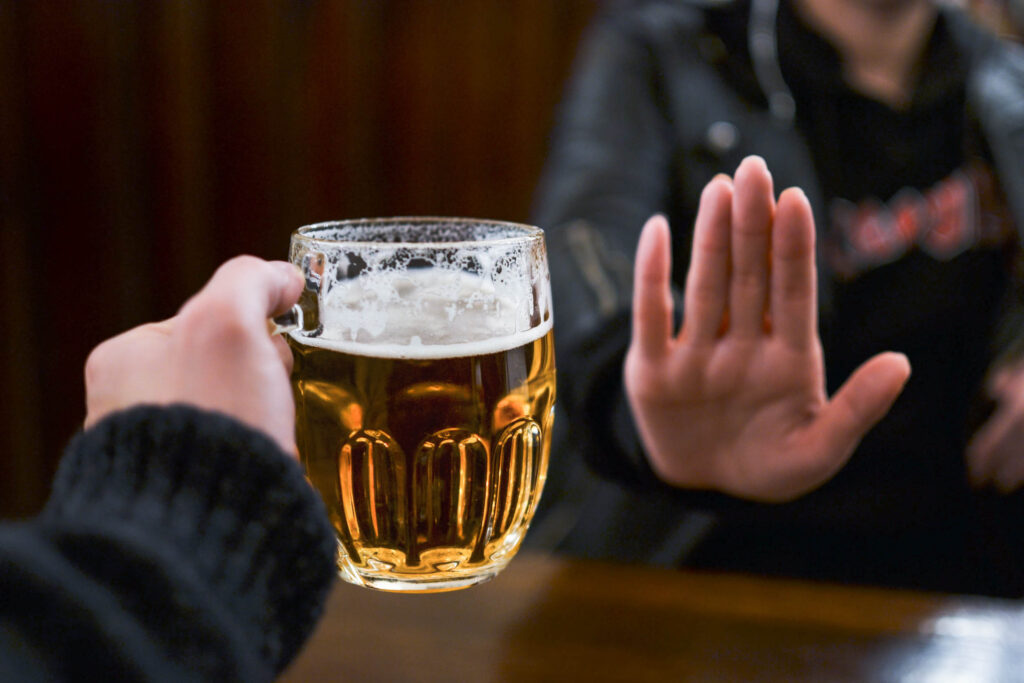April 18, 2023
Ready to Cut Back on Alcohol? Discover Your Sober Curious Side
The occasional cold beer on a hot day. A glass of wine with dinner. A cocktail at a holiday party. They’re simple pleasures, right? What could be the harm? It turns out, even simple pleasures can have a downside. Drinking alcohol is no different. That pleasant buzz can come with serious health risks if you overindulge or can’t control your drinking. Alcohol can actually:
Change your brain. Even casual drinking slows brain function. With heavy drinking, brain cells wither and die. The loss affects memory, mood, sleep and the body’s ability to regulate its temperature.
Short circuit your heart. Atrial fibrillation (AFib)—an irregular heart rhythm—can be triggered by even moderate drinking. AFib boosts the risk for stroke and dying from any cause.
Harden blood vessels. Heavy drinking releases stress hormones. These hormones harden blood vessels. Your heart has to work a lot harder to pump blood to other parts of the body.
Damage your liver. It can’t keep up with clearing out harmful toxins. Instead, the excess toxins cause a buildup of fat or scar tissue that stop the liver from working properly.
Weaken the immune system. Alcohol derails your body’s ability to fight bacteria and bio bugs that make you sick. Heavy drinkers have a higher risk for pneumonia, tuberculosis and more.
If that’s not sobering enough, experts say drinking even small amounts of alcohol boosts your risks for many kinds of cancer. Mouth, throat, esophagus, breast, colon and liver cancers are all linked to alcohol.
So, What Is the Safe Zone When It Comes to Sipping?
If you do choose to enjoy an adult beverage from time to time, you probably want to do so without harming your health. Experts advise that if you do drink, do so in moderation. That may sound like good advice, but what exactly does moderation mean?
In Dietary Guidelines for Americans, the Centers for Disease Control and Prevention (CDC) breaks out moderate, heavy and the most harmful type of drinking—binge—for both men and women.
Moderate drinking:
Women – No more than 1 drink per day
Men – No more than 2 drinks per day
Heavy drinking:
Women – 8+ drinks in a week
Men – 15+ drinks in a week
Binge drinking:
Women – 4+ drinks during a single occasion
Men – 5+ drinks during a single occasion
Worried You May Be Drinking Too Much Alcohol?
There are some warning signs that offer clues. Ask yourself these 10 questions. Do you:
- Spend a lot of time drinking or recovering from it?
- Find it hard to limit the amount you drink?
- Want to cut down or stop drinking, but can’t?
- Crave alcohol or have the urge to drink?
- Let drinking interfere with work, school or your home life
- Skip activities you used to enjoy so you can drink?
- Continue to drink even though it’s causing problems in your life?
- Need to drink greater amounts of alcohol to feel good?
- Drink even though it makes you feel depressed?
- Have withdrawal symptoms (nausea, sweating, shaking)?
If you answered yes to one or more of these questions, talk with your doctor about your alcohol consumptions.
Are You Sober Curious?
If you are thinking about quitting alcohol or at least cutting back, there are lots of positive steps you can take to help. Here are a few to try.
Know your triggers.
Think about why you drink. Is it a way to cope with stress? Do you like the social aspect of it? Do you find yourself drinking in certain situations, with certain people or places? When you identify reasons why you drink, you can address them.
Find your inspiration.
Make a list of all the reasons you want to cut back or stop drinking. What’s on your bucket list? Do you want to feel healthier? Sleep better at night? Feel more connected to your family, friends and coworkers? Look at the list if you feel your resolve faltering.
Remove temptation.
 Toss out the alcohol. Remove it from your home. Take it out of your glovebox, satchel, briefcase, backpack—anywhere there may be a stash. Out of sight, out of mind, out of reach is a powerful strategy that makes quitting or cutting back easier.
Toss out the alcohol. Remove it from your home. Take it out of your glovebox, satchel, briefcase, backpack—anywhere there may be a stash. Out of sight, out of mind, out of reach is a powerful strategy that makes quitting or cutting back easier.
Put alcohol-free days on your calendar.
Ease into your less-alcohol lifestyle, if you need to. Start by picking two days a week to forego drinking. Be bolder, if you’re up for it, and abstain for a longer period of time—a week or a month. See and feel what it’s like to live with less or no alcohol in your life.
Stick with a limit.
Follow the CDC guidelines whenever you do imbibe. Remember to stay in the “moderate” sweet spot (women: one drink per day; men two per day) whenever you do sip your favorite beer wine or cocktail. Avoid the “heavy” drinking end of the spectrum (women: 8+ drinks per week; men 15+ drinks per week).
Try the slow-and-switch strategy.
Allow yourself one alcoholic beverage when you do drink. Sip it very slowly to make it last. Switch to soda, water or juice afterward. You can still socialize, relax and enjoy yourself. Just do it with non-alcoholic beverages for the rest of the time.
Get your mind off alcohol.
Stay busy. Engage your brain and body in other activities. Take a walk, hit the yoga matt, log some miles on your bike, or play a pickup game with the kiddos. Catch a movie or catch up with a friend. Play a musical instrument, read or take up a new hobby.
Don’t cave to peer pressure.
Let friends and family know you are trying to cut back. Ask for their support. Practice polite ways to turn down invitations to happy hour or other get togethers where alcohol will be served. Steer clear of people and places that make you want to drink.
Sources: Drinking Levels Defined, National Institute on Alcohol Abuse and Alcoholism, 2023; 6 Surprising Ways Alcohol Affects Health, Not Just Your Liver, Cleveland Clinic, 2020; Alcohol’s Effects on the Body, National Institute on Alcohol Abuse and Alcoholism, 2023; Alcohol Use and Your Health, Centers for Disease Control and Prevention, 2022; Alcohol Use Disorder, Mayo Clinic, 2022; 11 Ways to Curb Your Drinking, Harvard Health Publishing, 2022.
DISCLAIMER
The information featured in this site is general in nature. The site provides health information designed to complement your personal health management. It does not provide medical advice or health services and is not meant to replace professional advice or imply coverage of specific clinical services or products. The inclusion of links to other web sites does not imply any endorsement of the material on such websites.



